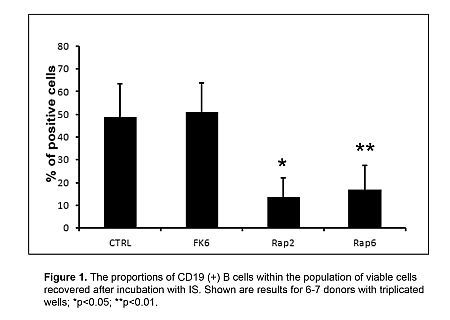Different Effects of mTOR Inhibitor VS CN Inhibitor on Human B Cells Proliferations and Activation Markers
Nephrology/Medicine, Northwestern University, Chicago, IL
Renal-Electrolyte/Medicine, University of Pittsburgh School of Medicine, Pittsburgh, PA
Meeting: 2013 American Transplant Congress
Abstract number: D1467
Background: Humoral immunity is increasingly recognized as an important factor in promoting transplant rejection. However, it is not well known how commonly used immunosuppressive drugs CN inhibitors (Tacrolimus, TAC) or mTOR inhibitors (Sirolimus, SRL) impact the differentiation and activation of subpopulations of human B cells.
Method: Peripheral blood mononuclear cells were isolated from healthy volunteers and CD19+ B cells were selected using CD19 magnetic microbeads and cultured in the presence of anti-IgM, anti-CD40, IL-21 (BCR/CD40-stimulation) for 6 days. A variety of parameters of B cell activity including proliferation, activation, differentiation and cytokine productions were monitored by flow cytometry.
Results: SRL at clinically relevant concentrations (e.g. 6 ng/ml) profoundly inhibited CD19+ B cell proliferation (up to ∼2 folds) compared to controls whereas TAC at 6-10 ng/ml had a minimal effect (Fig. 1). SRL, but not TAC inhibits the proliferation of CD19+CD27- naÏve and CD19+CD27+ memory B cells.
SRL effectively blocked plasma cell differentiation (% of CD19+CD138+) even at low dose (e.g. 2 ng/ml), and totally eliminated this cell population at over 6 ng/ml (% of CD19+ CD138+ and % of Blimp1+/Pax5 (low) transcriptional factors), but both SRL and TAC decreased % of CD24hiCD38hi Breg subset without affecting CD21hiCD23hi Breg subset. B cells cultured in the presence of SRL result in a population shift toward an activated phenotype (CD25+/CD69+) which resembles follicular B cells (CD21-CD23+IgM+IgD+).
Conclusions: The data show that SRL and TAC have different effects on B cells proliferation and differentiation. This study can help to define the use of immunosuppressive drugs in humoral alloimmune responces in transplantation.

To cite this abstract in AMA style:
Monica GLa, Xu L, Chalasani G, Gallon L. Different Effects of mTOR Inhibitor VS CN Inhibitor on Human B Cells Proliferations and Activation Markers [abstract]. Am J Transplant. 2013; 13 (suppl 5). https://atcmeetingabstracts.com/abstract/different-effects-of-mtor-inhibitor-vs-cn-inhibitor-on-human-b-cells-proliferations-and-activation-markers/. Accessed December 4, 2025.« Back to 2013 American Transplant Congress
